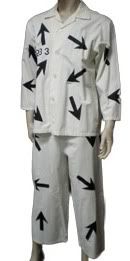Moore Bettah Ukuleles
Well-known member
You've seen the arrows, they're on every sanding roll or belt I own. Meant so that you can orient the sandpaper in the direction of movement on either a belt or drum sander. I've never paid any attention to them because I could never believe the grit was oriented in any particular direction. On pre made belts, I assumed it had to do with how the joint was made but that wouldn't explain the 100' rolls I use on my drum sander. Another builder friend of mine swears that the arrows are put there for a reason and that it matters. Anyone know the story on these arrows?


